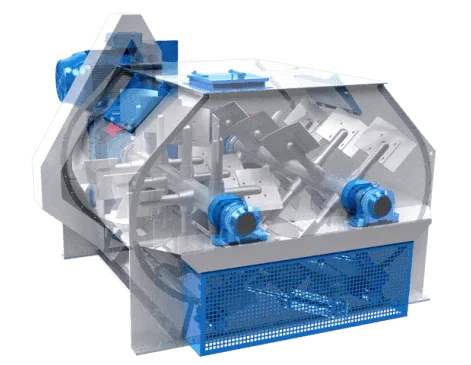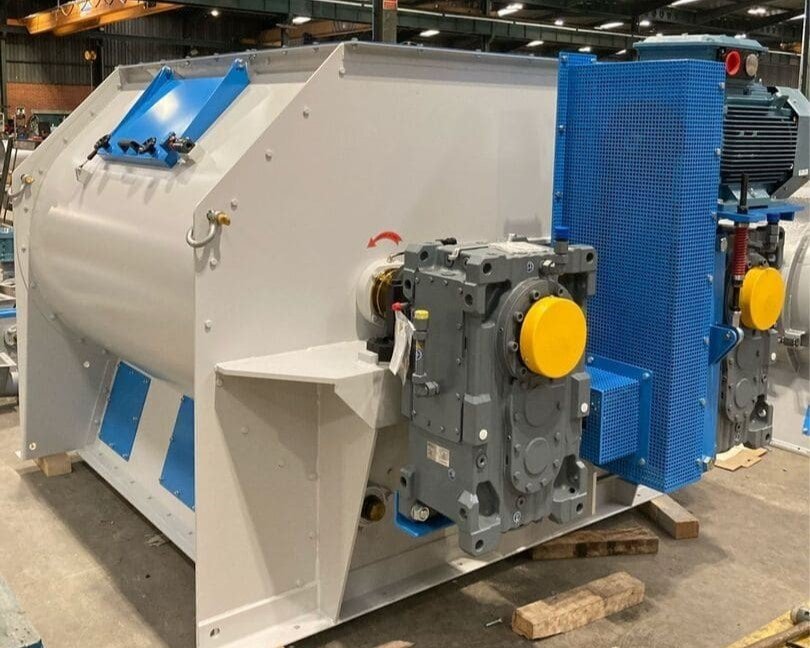MIXING
Twin shaft paddle mixer
The twin-shaft mixer is ideal for mixing products with very different textures, such as pellets, flours, extrudates and flakes. Its design allows for minimum retention times, which prevents the texture of the components from being impaired during the process. In addition, it is particularly suitable for the application of enzymes in pellets, ensuring efficient and gentle mixing to preserve product quality.
The Rosal mixers are designed to be durable and require minimal maintenance.

Features

Design
Wide range of models
Rosal has a wide range of models of double rotor mixers, from 500 to 6000 liters.
The body of the double rotor mixer is cylindrical, adapting to the path of the blades along the entire vertical axis.
The twin-shaft mixer is designed with a bolted, adjustable and interchangeable rotor blades, which allows for great versatility and adaptability in the mixing process.
Models
| Model | Nominal capacity (liters) | Total width (mm) | Tank length (mm) | Motor power (kW) |
|---|---|---|---|---|
| MDR-500 | 500 | 1460 | 960 | 11 |
| MDR-1000 | 1000 | 1825 | 1200 | 22 |
| MDR-2000 | 2000 | 2300 | 1500 | 30 |
| MDR-3000 | 3000 | 2620 | 1755 | 37 |
| MDR-4000 | 4000 | 2900 | 1900 | 45 |
| MDR-5000 | 5000 | 3000 | 2000 | 55 |
| MDR-6000 | 6000 | 3350 | 2350 | 75 |
Frequently Asked Questions
The standard mixing time is approximately 4 minutes, although it may vary depending on the formula and ingredients used.
The tanks are manufactured in AISI 316 stainless steel or carbon steel, with thicknesses ranging from 4 to 10 mm depending on the capacity of the equipment. The rotors are made of treated carbon steel for greater durability.
Yes, the mixers are prepared for the addition of vaporized liquids by means of integrated spray systems, allowing the mixture to be enriched with oils, molasses or other additives.
Dual-rotor mixers have two shafts with blades rotating in opposite directions, generating a cross flow. Single-rotor mixers have a central shaft with blades in one direction only.
The double rotor offers faster mixing with more uniform distribution and shorter processing time per batch. In addition, this configuration minimizes vibration and noise during operation, improving operating conditions and reducing required maintenance.
The shafts of a double rotor mixer are synchronized by means of a mechanical transmission system that guarantees a coordinated rotation, ensuring homogeneous mixing without interferences between blades.
MDR Rosal mixers are certified according to ATEX Directive 94/9/EC, and have the designation: EX II 3D T195°C. This means that they are approved for use in areas classified as zone 22, where dust explosive atmospheres may occasionally occur.
The pneumatic vibrator is activated after the complete opening of the tilting gate to promote the product fall. It must be deactivated before closing to avoid mechanical damage.
Every 50 h: cleaning and thermal control.
Every 1000 h: check oil, leaks and electrical components.
Every 2000 h: greasing of bearings and seals.
Every 25,000 h: disassembly and replacement of bearings.
Request more information
Leave us your data and questions and a technician in double rotor mixers will advise you without obligation. Let's talk!
Related machinery
Ribbon and paddle mixer
Ribbon or paddle mixers ensure effective homogenization.
Turbulence mixer
The vertical mixer achieves optimum homogenization levels without deteriorating the product.
